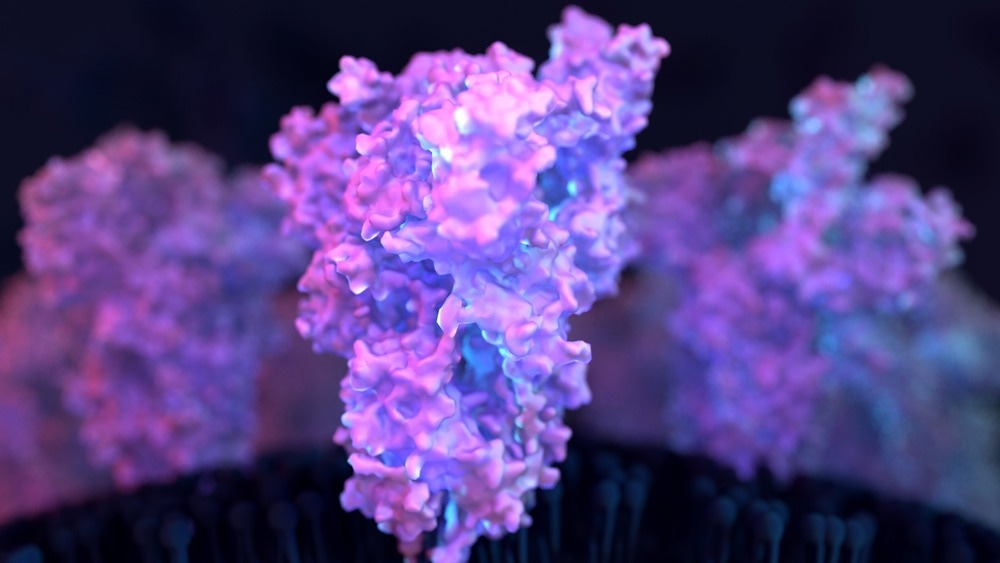In a recent study posted to the bioRxiv* preprint server, a team of researchers investigated the change in the stability, antigenicity, and protein expression of the severe acute respiratory syndrome coronavirus 2 (SARS-CoV-2) spike protein trimer using structure-directed mutagenesis to alter a cavity in the core of the spike protein.
 Study: Enhanced stability of the SARS CoV-2 spike glycoprotein trimer following modification of an alanine cavity in the protein core. Image Credit: Design_Cells/Shutterstock
Study: Enhanced stability of the SARS CoV-2 spike glycoprotein trimer following modification of an alanine cavity in the protein core. Image Credit: Design_Cells/Shutterstock

 *Important notice: bioRxiv publishes preliminary scientific reports that are not peer-reviewed and, therefore, should not be regarded as conclusive, guide clinical practice/health-related behavior, or treated as established information.
*Important notice: bioRxiv publishes preliminary scientific reports that are not peer-reviewed and, therefore, should not be regarded as conclusive, guide clinical practice/health-related behavior, or treated as established information.
Background
Many coronavirus disease 2019 (COVID-19) vaccines are based on the SARS-CoV-2 spike protein, and they have significantly reduced the severity of the disease. The spike protein consists of two subunits, S1 and S2, separated by furin cleavage. The receptor binding domain in the S1 subunit attaches to the angiotensin-converting enzyme-2 (ACE-2) receptor in the host cell. The S2 subunit containing the fusion peptide mediates viral entry into the host cell.
Membrane fusion is associated with changes in the coiled-coil structure of class I viral glycoproteins, of which the SARS-CoV-2 S2 subunit is an example. The inward-facing positions in the SARS-CoV-2 S2 coiled coil are polar residues that come close together and form hydrogen bonds in the post-fusion spike trimer. In the prefusion spike trimer coiled-coil, alanine residues in positions 1016 and 1020 form a cavity in the hydrophobic core formed due to interactions between isoleucine and leucine residues in the 1013 and 1012 positions, respectively.
Protein folding studies have revealed that such protein core cavities can destabilize the protein, and the thermal stability can be improved by using bulkier hydrophobic residues to fill the cavity. Using this technique to improve the stability of SARS-CoV-2 spike protein antigens could elicit more stable and long-lived immune responses to vaccines.
About the study
In the present study, the researchers used a cytomegalovirus promoter, residues from the S glycoprotein of the ancestral Wuhan Hu-1 strain, furin cleavage mutation, substitutions, and C-terminal domain of T4 bacteriophage fibritin (T4 foldon), oct-histidine, and avitag sequences to produce the prefusion-stabilized two-proline spike trimer S2P-FHA. Synthetic genes which coded for mutated S2P fragments were introduced into S2P-FHA.
Additionally, the S2P-1208.H8 expression vector comprising ectodomain sequences from the ancestral Wuhan Hu-1 strain and SARS-CoV-2 Omicron BA.1 and BA.4/BA.5 was derived from the S2P-FHA plasmids. Divalent cation affinity chromatography was used to partially purify the S2P-FHA protein. Protein purification was then performed using size exclusion chromatography (SEC) and sodium dodecyl sulfate-polyacrylamide gel electrophoresis (SDS-PAGE).
The thermostability of the protein was assessed using differential scanning fluorimetry. Western blot analysis confirmed the expression of wild-type and mutated spike glycoprotein in transfected cells, while the membrane fusion ability of the spike glycoproteins was measured using cell-cell fusion assays. The fusion activity of the mutated spike proteins was determined through a luciferase assay.
Guinea pig models were used to determine the immunogenicity of the S2P-FHA trimers carrying alanine cavity mutations. Spike pseudotyped human immunodeficiency virus luciferase viruses were used to determine the neutralizing activity of the serum from vaccinated animals. Additionally, serum-monoclonal neutralizing antibody cross-competition enzyme-linked immunosorbent assay (ELISA) was used to determine the antigenic sites within the spike protein targeted by the vaccine-induced antibodies.
Results
The results reported improved thermostability of the prefusion-stabilized spike trimer S2P-FHA after the alanine residue in the 1016 position was replaced with a bulkier hydrophobic residue. Furthermore, filling the alanine 1016/ 1020 cavity with bulkier residues also increased the membrane fusion activity of the spike glycoprotein.
Of the various S2P-FHA mutants produced, two mutants elicited high neutralizing antibody titers against the ancestral Wuhan-Hu-1 strain and the Delta variant. In one of the mutants (16L), the alanine in the 1016 position was replaced with a leucine residue, while in the other mutant (VI), the 1016 and 1020 alanine residues were replaced with valine and isoleucine, respectively. However, the neutralizing antibodies elicited by these mutants against the Omicron BA.1 subvariant were comparatively lower.
Furthermore, the mutated antigens elicited neutralizing antibodies that competed with the ACE-2 receptor for the receptor binding motif of the spike and recognized epitopes in the N-terminal domain, receptor binding domain, and stem of the spike S2 subunit. The VI mutant produced stable Omicron BA.1 and BA.4/BA.5 spike ectodomain trimers without requiring an external T4 foldon trimerization motif.
Conclusions
To summarize, the study investigated the production of thermostable SARS-CoV-2 spike protein trimers by filling the cavity formed between two alanine residues in the coiled-coil core of the S2 subunit by replacing one or both alanine residues with bulkier hydrophobic residues.
The results indicated that the VI mutant stably expressed spike ectodomain trimers of Omicron BA.1 and BA.4/BA.5 subvariants without needing an external trimerization motif. The VI mutant can produce stable spike trimer glycoprotein vaccines for booster doses to strengthen the immune response against the emergent Omicron subvariants.

 *Important notice: bioRxiv publishes preliminary scientific reports that are not peer-reviewed and, therefore, should not be regarded as conclusive, guide clinical practice/health-related behavior, or treated as established information.
*Important notice: bioRxiv publishes preliminary scientific reports that are not peer-reviewed and, therefore, should not be regarded as conclusive, guide clinical practice/health-related behavior, or treated as established information.